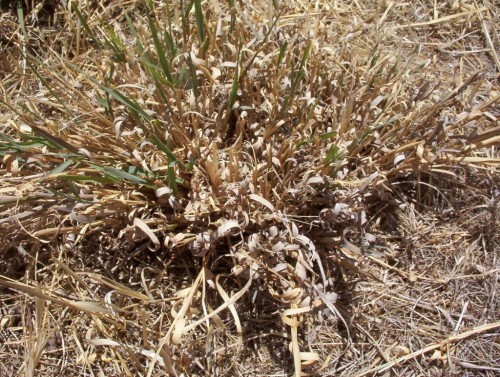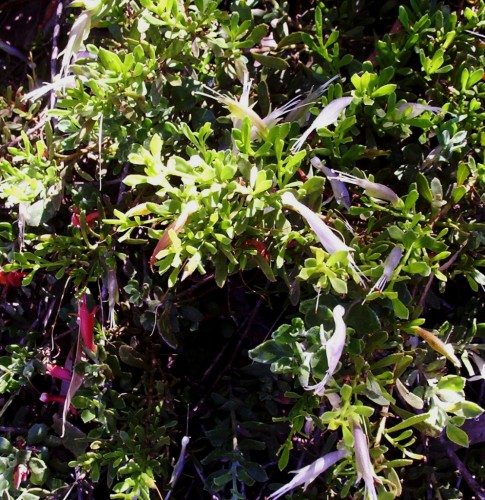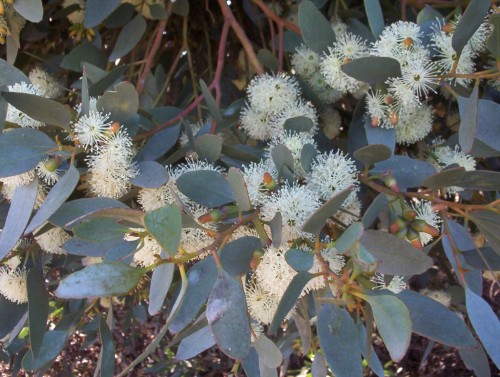Chloris truncata (Windmill Grass)
After I decided to not water a patch until it became unacceptable as a lawn to test the time between waterings, we had 3.5 mm of rain. This was three and a half weeks between waterings and was almost at the stage of considering it to be in need of a watering. As a general rule I would say that 3 weekly intervals would keep a reasonable greenness about the grass. It is looking a bit tatty at the moment as it hasn’t been trimmed since late spring. We have also had many days above 35C and at least ten days above 40C.
I certainly think it is worth persevering with this grass in low rainfall areas, especially in areas where it occurs naturally.
Olearia passerinoides (Daisy Bush)
This plant is native to the district and is drought and lime tolerant. They are shrubs to about 3 metres tall and 2 metres wide. Not much study has been done on Olearias and their cultivation. The dryland plants need to be pruned to prevent the flowers appearing on the whispy ends of foliage. New growth appears low down in the bush and pruning can be done at these points to force out more dense foliage and create a tidier bush.
Daisy bushes attract butterflies and the birds that chase them. The birds in our yard use the bushes as staging posts to come down to the bird baths.
Eremophila veneta (metallica) and Birds
Eremophila veneta is a hardy ground covering plant with silver and green flowers. It grows to about 15-30cm tall by 1-1.5m wide. It thrives in a dry, hot position with good drainage.
I am sure that the Shingle Back Lizards find the water in the bird bath which is on the ground in the same way. I have watched them walk quite a distance in a very purposeful manner, heading in a direct line for the dish.
More information can be found here.
Eremophilas (Emu Bushes) and Birds
The antics of the New Holland Honeyeater are amusing. There is a daisy bush growing beside this plant and it has light twiggy growth low down in the bush. The New Holland Honeyeaters hang by their claws like a trapeze artist to reach their beaks and long tongues into the flowers. Then they decide that it is just as easy to get at the nectar by hopping all over the plant as the other species do.
This particular plant has made roots along some stems and in doing so collects more moisture. The Eremophila glabra forms are all very hardy but like all plants appreciates water during mid summer. We had 33mm (about an inch and a quarter) rainfall last weekend and everything has perked up even though this rain was sopped up by the ground very quickly.
More information about Honeyeaters can be found at Trevor’s Birding.
Eucalyptus platypus (Moort)
Eucalyptus platypus is a Western Australian tree 4-10 metres high by 5-10 metres wide. It flowers from spring through to autumn, the flowers being creamy yellow as in the varieties growing around here, to greenish yellow. Apparently there is a red form also which is rare but would be beautiful given how floriferous this plant is.
This tree is fast growing and particularly suited to heavy soils. It tolerates some water logging and is hardy to drought and most frosts. It is highly resistant to smog. The trees respond well to pruning and coppicing. They have many uses including shelter belts and wind erosion control. The foliage grows low down on the plant giving the impression of a large shrubby tree. This aspect makes it a great plant for wind breaks. It is also a good plant for bee keepers.




